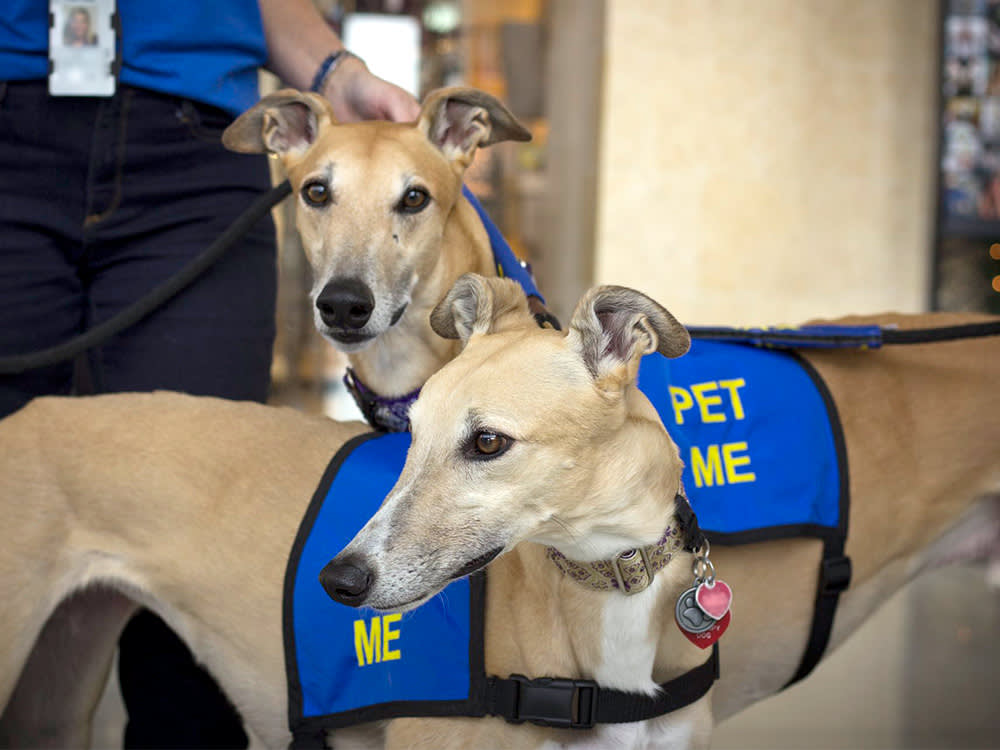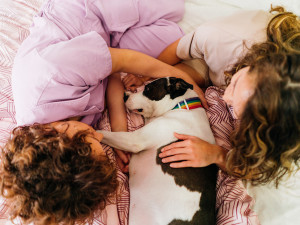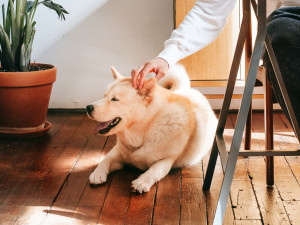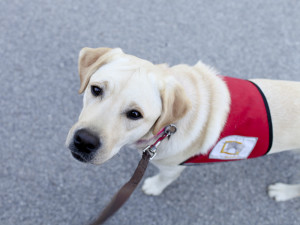Stress Busting Benefits of Airport Therapy Dogs
These working dogs calm harried travelers.

Share Article
Traffic on the way to the airport makes you late. Rushing, fearing you’ll miss your flight, you anxiously stand in endless check-in and security lines, annoyed at the delay. Your stress level increases with every passing minute. Finally clearing security, sitting to put your shoes back on, you notice something unusual across the room: an enormous harlequin Great Dane wearing a vest that says, “Pet me!” A smile breaks across your face, and your blood pressure immediately drops. You say a quick hello to the dog and rub his soft ears, and the tension of the past hours melt away.
Introducing Airport Therapy Dogs
You’re used to seeing security dogs at airports, but those dogs are working — no petting allowed. Airport therapy dogs are a different story altogether, reflecting the industry’s growing understanding that helping passengers destressopens in a new tab, especially during busy holiday flying seasons, has value. These dogs are all about being touched.

Get (totally free) deals for food, treats, accessories, tech, and way more pet parenting must-haves.
opens in a new tabSo far, some 30 airports across the country have therapy dogs on duty, and luckily for travelers, the number is steadily growing. The idea started at California’s Mineta San Jose International Airportopens in a new tab shortly after 9/11 as a way to ease traveler jitters. Videos of those dogs at work convinced other airports to give it a go.
The distinctively outfitted dogs and their handlers position themselves throughout the airport, from check-in to boarding — wherever passengers can use some calming canine loveopens in a new tab. Recognizing that not everyone loves dogs, the teams typically remain stationary in an open area so those who wish to greet the dogs can do so while anyone not so fond of dogs can easily avoid them.
As of August 2021, there are reportedly 37 airports running airport therapy dog programs. Here are a few of the airports with therapy dogs.
Charleston International Airport
Dallas Fort Worth Airport
Denver International Airport
John Wayne International Airport
Los Angeles International Airport
Louis Armstrong New Orleans Air
Minneapolis-Saint Paul International Airport
Orlando International Airport
Phoenix Sky Harbor International Airport
Pittsburgh International Airport
Sacramento International Airport
San Diego International Airport
San Jose International Airport
Airport Therapy Dogs in Charlotte
One of the most recent converts to the service, North Carolina’s Charlotte Douglas International Airport, began deploying professionally certified therapy dogsopens in a new tab in March 2015. The all-volunteer CLT Canine Crewopens in a new tab provides coverage daily between 10 am and 4 pm. “We wanted a way to create a sense of place,” says Lauri Golden, supervisor of the CLT Canine Crew. “Our airport is a hub for American Airlines; 70 percent of traffic is connections, so the passengers just see the facility, not the city.”
Initially, Golden worried about finding enough volunteer teams. However, the pilot program created to iron out the logistics was an instant success. “We expected that kids would like the dogs, but even more, it’s the adults benefiting from them,” she says. “They pull out photos of their own dogs; talk about ones recently lost; take selfies; ask the name, age, and breed of the dog … lots of questions. The dogs create a gathering, an audience, which creates its own community as people talk to each other, sharing dog stories. They are our superstars.” The demand for teams is high, and Golden is constantly recruiting.
Max the Great Dane and his handler Fred McCraven make up one of the Charlotte teams. “When I asked Fred why he wanted to join, he was so honest: ‘I just want to show off my dog.’ Max is a complete sweetheart!” says Golden.
Fred thoroughly enjoys taking Max to the airport. “Some tourists just light up when they see Max and take photos,” he says. “Some look at him funny, like, ‘Please don’t bring that big dog near me.’ I try to gauge peoples’ reactions. Even those who don’t come up to touch Max are smiling. I once met a woman who was traveling to her brother’s funeral. Her brother had a Great Dane as well, and she took it as a sign her brother was okay.”
LAX Therapy Dogs
Los Angeles World Airports (LAX) was the third to create a therapy dog program, after San Jose and Miami. Pets Unstressing Passengersopens in a new tab (PUP), which launched in April 2013 with 30 teams, now has 52, allowing them to have dogs in most terminals every day of the week. Each PUP dog has their own baseball card–style ID, which is given to passengers as a keepsake.
Heubner enjoys observing the interactions between volunteer teams and passengers. “The dogs bring strangers together,” says Heidi Heubner the director of PUP. “We’re often afraid to talk, or are on our devices, but with the dogs, people are sharing stories and photos of their own dogs, talking about where they’re going. I never get tired of watching them. Sometimes my face hurts from smiling so much, watching them in action, and listening to what the passengers are saying.”
Therapy teams are also called upon to calm passengers when things don’t go as planned, Heubner notes. “One day, a flight was canceled. A flight attendant asked if one of the dogs could visit with the passengers. The passengers loved it, and were saying, ‘Who cares that we’re delayed! It was worth it to see the dogs.’”
Are Airport Therapy Dogs Certified?
Airport therapy dogs come in all sizes and breeds, but the thing they have in common is that they’re all certified by one of the country’s therapy-dog organizations; for example, Charlotte and LAX use teams certified by the Alliance of Therapy Dogsopens in a new tab. New teams do an initial walk-through at the facility to make sure the dog is comfortable with the noises, smells, and crowds of strangers. If that goes well, they’ll go through a more thorough vetting, with the human half of the team undergoing background and security checks. Once approved, teams typically work one day a week.

Rebecca Wallick, J.D.
Rebecca Wallick, was long-time contributing editor for The Bark magazine and retired family law attorney, she lives with two dogs and runs mountain trails at every opportunity.
Related articles
![Man hugging his fluffy white dog happily]() opens in a new tab
opens in a new tabChemistry Between People and Dogs Is Real (It’s Science)
How the “love hormone” oxytocin connects us with our pups.
![Happy young woman in yoga clothes holding small tan dog in park]() opens in a new tab
opens in a new tabThe Healthiest Thing You Can Do Is Get a Dog, Harvard Report Says
Scientists confirm the myriad physical and psychological benefits of pet parenthood.
![Unrecognizable man sitting at desk petting his dog]() opens in a new tab
opens in a new tabHow to Pet a Dog — Yes, You Do Need Lessons
There’s a difference between being affectionate and being annoying.
![A service dog for PTSD walking outside looking up at the camera]() opens in a new tab
opens in a new tabHow Service Dogs Can Ease Veterans’ PTSD
According to a study, trained service dogs can interrupt panic attacks, wake veterans from nightmares, and more.





